|
Chapter Eleven
EXILES ON A
SHIFTING EARTH
"When the Spaniards, and then other Europeans, realized how numerous
were the similarities in traditions, customs, and beliefs between
those of the American natives and those who have been associated
with the Bible and the Hebrews, they could think of no other
explanation but the "Indians" were descendants of the
Ten Lost
Tribes of Israel. That harkened back to the mystery of the
whereabouts of the people belonging to the ten Israelite tribes that
formed the Northern Kingdom who were forced into exile by the
Assyrian king Shalmaneser.
"....While the exile of the ten tribes by the Assyrians in the
eighth century B.C., and then of the remaining two tribes by the
Babylonians two centuries later, are historical facts, the "Ten
Tribes Connection" to the New World remains in the realm of
intriguing legends. Yet, unknowingly, the Spaniards were right in
attributing the beginning of a formal civilization, with its own
calendar, in the Americas to an exile; but not of people - rather,
the exile of a god.
"The peoples of Mesoamerica - the
Maya and Aztecs, Toltecs and
Olmecs and lesser known tribes - had three calendars. Two were
cyclical, measuring the cycles of the Sun and the Moon and of Venus.
The other was chronological, measuring the passage of time from a
certain starting point, "Point Zero."
"....In
The Lost Realms we have suggested that it marked the date of
the arrival of Thoth, with a small band of aids and followers, in
America.
"Quetzalcoatl, the Great God of the Mesoamericans, was none other
than Thoth, we have suggested.... Quetzalcoatl, like
Thoth, was the
god who knew and taught the secrets of temple building, numbers,
astronomy, and the calendar. Indeed, the two other calendars of
Mesoamerica by themselves offer clues for the Egyptian Connection
and for identifying Quetzalcoatl as Thoth.
"First of the two was
the Haab, a solar-year calendar of 365 days
that it was subdivided into 18 months of 20 days each, plus an
additional five special days at yearís end. Although the 18 x 20
division is different from the Near Eastern one of 12 x 30, this
calendar was basically an adaptation of 360 days plus 5.
"....That
purely solar calendar did not allow for intercalation - a
device that, in Mesopotamia, was expressed in the addition of a
thirteenth month once in a given number of years. In Mesopotamia this
number, 13, featured in the next calendar.
Mr. Sitchin has explained the variations of the calendar in previous
chapters, but he makes a point later in this chapter about the
meshing together of the two calendars....
"to create the grand
Sacred Round of fifty-two solar years, for the
combination of 13, 20 and 365 could not repeat itself except once in
18,980 days, which meant fifty-two years.
"....The centrality of the number fifty-two, if nothing else, as a
hallmark of religious and messianic Mesoamerican beliefs and
expectations, pointed to a key similarity between Quetzalcoatl and
his Sacred Calendar and Thothís calendar of fifty-two. The game of
Fifty-two was Thothís game, and the Tale of Satni earlier related
clearly stated that "fifty-two was the magical number of Thoth." We
have already explained the significance, in terms of Thothís feud
with Ra/Marduk, of the Egyptian calendar of fifty-two weeks. The
Mesoamerican "fifty-two" had "Thoth" stamped all over it.
"Another hallmark of Thoth was the application of a circular design
to edifices related to the calendrical observation of the heavens.
The Mesopotamian ziggurats were squarish.... Near Eastern temples -
Mesopotamian, Egyptian, Canaanite, even Israelite - were
rectangular.... Only in the unique edifice that Thoth helped build
in Lagash was a circular shape adopted. Its only other Near Eastern
emulation was at the temple dedicated to Hathor (i.e Ninharsag) at
Denderah; and at Stonehenge, near where the Old World faces the New
World on the other side of the Atlantic Ocean.
"....If as we believe, he was
the Divine Architect of the circular
observatories, he was certainly present in the Sacred Valley. His
hallmarks among the structures of the Megalithic Age were the
Round
Observatory atop the Sacsahuaman promontory, the
semicircular Holy
of Holies in Cuzco, the Torreon in Machu Picchu.
|
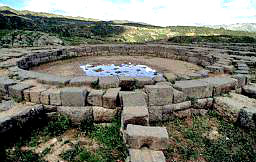
Sacsahuaman
|
 |
"The actual domain of
Quetzalcoatl/Thoth was Mesoamerica and Central America, the lands of
the Nahuatl-speaking and Mayan tribes; but his influence extended
southward into the northern parts of the South American continent.
Petroglyphs found near Cajamarca in the north of
Peru that depict
the Sun, the Moon, five pointed stars, and other celestial symbols
of the serpent - the unmistakable emblem of Enki and his clan and
specifically so of the deity known as the "Plumed Serpent." The
petroglyphs also include depictions of astronomical viewing devices,
one held by a person (priest?), as was customary in the Near East,
and the other with the curved horns, as were the viewing devices
erected in Egypt as the temples of Min.
"The site appears to have been where ancient routes in the gold
lands of the Andes, from the Pacific coast and from the Atlantic
coast, met as the latter followed the rivers. Cajamarca itself,
somewhat inland and the natural port for it at Trujillo on the
Pacific coast, in fact played a historic role in the European
conquest of Peru. It was there, at Trujillo, that
Francisco Pizarro
and his small band of soldiers landed in 1530. They marched inland
and established their base at Cajamarca, a city "whose plaza was
larger than any in Spain" and "whose buildings were three times the
height of a man," according to the reports of the Conquistadors. It
was to Cajamarca that the last Inca emperor, Atahualpa, was lured,
only to be imprisoned for a ransom of gold and silver.
|

Ruins of
Chan Chan, the ancient capital of the Chimu Empire,
Trujillo, Peru. |

|
There are other finds of
petroglyphs along the Magdalena River in
Colombia, representing the
Hittite and Egyptian encounters.... In the tomb area of Holmul,
Guatemala, a drawing of a pyramid is found....
"Incredible as it may sound, reference to petroglyphs with
astronomical symbols is made in ancient Near Eastern writings. The
Book of Jubilees, enlarging and fleshing out the biblical record of
the generations that followed the Deluge, describes how
Noah
instructed his descendants by relating to them the tale of Enoch and
the knowledge that was granted him. The narrative continued thus:
"In the twenty-ninth jubilee, in the first week, in the beginning
thereof, Arpachshad took to himself a wife and her name was
Rasuíeja,
the daughter of Shushan, the daughter of Elam, and she bare him a
son in the third year in this week, and he called his name Kainam.
And the son grew, and his father taught him writing, and he went to
seek for himself a place which he might occupy as a city for
himself.
And he found a writing which former generations had carved on the
rock, and he read what there was thereon, and he transcribed it and
sinned as a result thereof; for it contained the teaching of the
Guardians in accordance with which they used to observe the omens of
the sun and moon and stars in all the signs of heaven."
"The petroglyphs, we learn from this
millennia-old text, were not
mere graffiti; they were expressions of knowledge of the "teachings
of the Guardians" - the Anunnaki -" in accordance with which they
used to observe the omens of the Sun and the Moon and the stars";
the petroglyphs were the "signs of heaven" of "former generations."
|
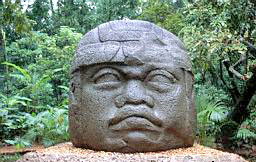
Giant Olmec
Head, from La Venta |
"Indeed, in the
heartland of Quetzalcoatlís domain, where the petroglyphs evolved
into hieroglyphs akin to the earliest ones in Egypt, the most
obvious traces of his presence are astronomically aligned temples,
including circular and semicircular ones, and round observatories.
Such remains begin with two perfectly round mounds that marked out
the astronomical sightline at La Venta, one of the earliest sites of
the Olmecs - African followers of Thoth who had arrived in
Mexico by
crossing the Atlantic circa 2500 B.C.
"....Four
millennia passed since then till the Spanish conquest, the
latest instance of observatory in-the-round was the semicircular
pyramid in the sacred precinct of the Aztecs in
Tenochtitlan (later
Mexico City).
"Chronologically, between the early
Olmecs and the late Aztecs....
|
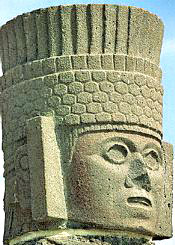
Aztec
warriors, the one above is 15 feet high and used to
support Quetzalcoatlís Pyramid roof, wearing his
insignias. |
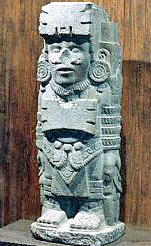
|
"....were the countless
pyramids and sacred observatories of the Mayas. Some of them, as the
one at Cuicuilco were perfectly round. Others, like the one at
Cempoala began, as archaeologists have established, as purely round
structures but in time changed shape as the small original stairways
leading to their top stages evolved into monumental stairways and
plazas. The most renown of these structures is the Caracol in
Chichen Itza, in the Yucatan peninsula - a circular observatory
whose astronomical functions and orientations have been extensively
and firmly established.
|

|
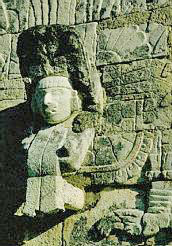
Mayan Heads
of Warriors |
|

Examples of
original small stairway on a Mayan Pyramid, at above;
and of the monumental stairway at El Caracol, Yucatan
(right) |
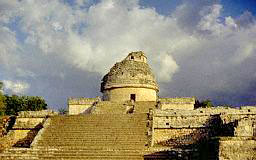
|
"The sightlines in the
existing structure have been excessively researched, and undoubtedly
include the principal points of the Sun - the equinoxes and
solstices, as well as some of the Moonís major points. Alignments
with various stars are also suggested, though not with Venus; that
is odd, for in Maya codices the movements of Venus are the principal
subject. It is one of the reasons for believing that the sightlines
were not devised by Mayan astronomers, but were inherited by them
from previous eras.
"The Caracolís ground plan - a
round tower within a squarish
enclosure as part of a larger rectangular structural frame, and the
openings for sightlines in the tower itself - bring to mind the
shape and layout (now seen only by their foundations) of the
circular observatory within its square enclosure and larger
rectangular complex at Sacsahuaman above Cuzco. Is there much doubt
that both were designed by the same Divine Architect? In our
opinion, he was Thoth.
|
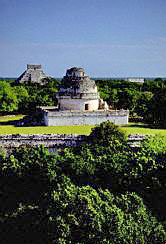
El Caracol
complex, Yucatan. |
|

Sacsahuaman,
Cuzco |
 |
"....Mayan astronomers
used viewing devices that are often depicted in the codices and the
similarities to Near Eastern instruments, viewing perches, and
symbols are too numerous to be just coincidence.
"....The links with the
ancient Near East in general, and with Egypt
in particular, that are evidence by glyphs and archaeological
remains are augmented by legends.
|
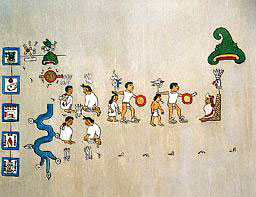
Illustration of
the Way of the Nahuatl |
"....Both Nahuatlan
traditions, as well as Mayan ones in such forms as the legend of
Votan, recount the arrival of "the Fathers and the Mothers," the
tribal ancestors, from across the seas. The Annals of Cakchiquels, a
Nahuatlan record, states that while they themselves came from the
west, there were others who had come from the east, in both
instances "from the other side of the sea."
"The
Legend of Votan, who had built the first city, that was the
cradle of Mesoamerican civilization, was written down by Spanish
chroniclers from oral Mayan traditions. The emblem of Votan, they
recorded, was the serpent; "he was a descendant of
the Guardians, of
the race of Can."
"....The possibility, which we have already mentioned, that the
earlier migrants might have been descendants of Cain, relates
Nahuatlan beginnings to one of the first recorded forced
deportations....
"....It is clear from Nahuatlan and
Mayan legends that Quetzalcoatl
(Kukulkan in Mayan lore) had come to their lands with a small band
of followers, and that his eventual departure was a forced one - an
exile imposed by the War God. We believe that his arrival was also
the result of a forced departure, an exile, from his native land,
Egypt. The date of that first event is a vital component of the
Mesoamerican counts of Time.
"....The concept of Ages in Earthís history and prehistory was a
basic tenet of the pre-Columbian civilizations of Mesoamerica.
According to the Aztecs their Age or "Sun" was the
fifth one and
"began 5,042 years ago." While the Nahuatlan sources were not
specific about how much longer this age was to last, the Mayan
sources provided a more precise answer through the Long Count. The
present "Sun," they said, will last precisely thirteen baktuns -
1,872,000 days from Point Zero. This represents a Grand Cycle of
5,200 "perfect years" of 360 days each.
"In The Mayan Factor
Jose Arguelles concluded that each baktun date
had acted as a milestone in the history and prehistory of
Mesoamerica, as will the year A.D. 2012, in which the thirteen
baktuns that begun in 3113 B.C. will be completed. He deemed the
number 5,200 a key to understanding Mayan cosmogony and ages past
and future.
"....In arriving at A.D 2012 as the end of the
Fifth Sun, Jose
Arguelles followed the present custom of dividing the 1,872,000 days
by the actual number of 365.25 days in a solar year, resulting in
the passage of only 5,125 years since the starting point in 3113
B.C. Fritz Buck on the other hand saw no need for such an
adjustment, believing that the division should follow the Mayan 360
"perfect Year." According to Buck, the historic age through which
the Aztecs and Mayans had lived was to last a perfect 5,200 years.
This number, like fifty-two, is connected with Thoth according to
ancient Egyptian sources. Among them were the writings of an
Egyptian priest whom the Greeks called Manetho (his hieroglyphic
name meant "Gift of Thoth"). He recorded the division of monarchies
into dynasties, including the divine and semidivine ones that
preceded the pharaonic dynasties; he also provided lengths of reign
for all them.
"Corroborating legends and tales of the gods from other sources, the
list by Manetho asserts that
-
the seven great gods -
Ptah, Ra, Shu,
Geb, Osiris, Seth, and Horus - reigned a total of 12,300 years
-
hen
began a second divine dynasty, headed by Thoth; it lasted
1,570
years
-
it was followed by
thirty demigods who reigned 3,650 years
-
a
chaotic time followed, a period of 350 years during which Egypt was
disunited and in disarray
-
after that a person called
Men
established the first pharaonic dynasty. Scholars hold that this
happened circa 3100 B.C.
"We have held that the date was 3113 B.C., the starting point of the
Mesoamerican Long Count. It was then we believe, that Marduk/Ra,
reclaiming lordship over Egypt, expelled Thoth and his followers
from that land, forcing them into exile into another, distant land.
And if the preceding reign of Thoth himself (1,570 years) and of his
appointed demigods (3,650 years) is tallied, the result is 5,220
years - a mere discrepancy of 20 years from the 5,200 perfect years
that make up the Great Mayan Cycle of thirteen baktums.
"As with 52, so was 5,200 a "number of
Thoth."
"In the olden days, when the Anunnaki were the Lords, the banishment
and exile of gods marked milestones in what we have named The Earth
Chronicles. Much of that part of the tale concerns Marduk, alias
Ra
in Egypt; and the calendar - the count of Divine, Celestial, and
Earthly Time - played a major role in those events.
"....Ra, the
Great God, pointed an accusing finger at Thoth; the
accusation directly concerned changes in the calendar: Thoth,
Ra
accused, "their years cut short, their months had curbed." This
Thoth had achieved by "the destruction of Hidden Things that were
made for them."
"....The outcome could have only meant a
switch from the longer solar year to the shorter lunar year - the "making of the great into
small."
"....The exiling of Thoth was treated in Mesoamerica time keeping as
Point Zero of the Long Count, according to accepted chronology. In
the year 3113 B.C. It must have been an event whose repercussions
were recalled far and wide, for it could not be a mere coincidence
that according to Hindu traditions (that also divide Earthís history
and prehistory into Ages) the present Age, the Kaliyuga, began on a
day equivalent to midnight between February 17 and 18 in 3102 B.C.
"With Thoth gone and his brothers Nergal and
Gibil remote from the
center of Egyptian power, Ra/Marduk could have expected an
undisturbed supremacy there. But a new rival had emerged on the
scene. He was Dumuzi, the youngest son of Enki, and his domain was
the grasslands south of Upper Egypt.... Dumuziís bride was none
other than Inanna/Ishtar, a granddaughter of Enlil and one who had
fought alongside her brother and uncles to defeat the Enkiíites in
the Pyramid Wars.... Marduk was made a prisoner of the Pyramid....
buried alive there.... but rescued in time.... however, he was
sentenced to exile, and in Egypt Ra became Amen - the Hidden One, a
god no longer seen.
"Where was Thoth in the ensuing centuries, now that his exiler was
himself in exile? Apparently roaming distant - guiding the erection
of the first Stonehenge in the British Isles circa 2800 B.C.,
helping orient astronomically megalithic structures in the Andes.
Where was Marduk during that period? We really do not know, but he
must have been somewhere not too far away, for he was watching
developments in the Near East and continuing his scheming to seize
the supremacy of Earth - supremacy, he believed, wrongly denied to
his father Enki.
"In Mesopotamia Inanna, ruthless and cunning,
maneuvered the
kingship of Sumer into the hands of a gardener of her liking ....
Sharru-kin, "righteous ruler," known to us as
Sargon I.
Sargon enraged Marduk, because he had stolen sacred soil from
Babylon, so he destroyed Sargon and his people, and Marduk
reinstated himself in Babylon. There he began to fortify the city
and enhance its underground water system, making it impervious to
attack.
"Alarmed by the prospect of yet another devastating
War of the Gods,
the Anunnaki met in council. The chief antagonist was
Ninurta....
The chain of events, with dramatic and in the end fateful turns and
consequences, is described in detail in a text known as the Erra
Epos (Erra having been an epithet of Nergal). It includes many of
the verbal exchanges between the participants as though a
stenographer were present; and indeed, the text (as its proscript
attests) was dictated to a scribe after the events by one of the
participating Anunnaki.
"As the story unfolds, it becomes increasingly clear that what was
happening on Earth had been related to the heavens - to the
constellations of the zodiac. In retrospect, the statements and
positions taken by the contestants for the supremacy of Earth -
Marduk the son of Enki and Ninurta the son of
Enlil - lead to no
other conclusion than that the issue was the coming of a New Age:
the impending change from the zodiac house of the bull (Taurus) to
the zodiac house of the ram (Aries) as the one in which the spring
equinox, and thus the calendrical moment for the New Year, would
occur.
"Listing all the attributes and heirlooms, Ninurta thus asserted:
In Heaven I am a wild bull,
On Earth I am a lion.
In the land I am the lord,
among the gods I am the fiercest.
The hero of the Igigi I am,
among the Anunnaki I am powerful.
"Carefully, choosing his words,
Nergal formulated his answer to the
assertive Ninurta. Yes, he said, all that is true. But:
On the mountaintop,
in the bush-thicket,
see you not the Ram?
"Its emergence,
Nergal continued, is unavoidable:
In that grove,
even the supermost time measurer,
the bearer of the standards,
the course cannot change.
Once can blow like a wind,
roar like a storm, [yet]
on the rim of the Sunís orbit,
no matter what the struggle,
see the Ram.
"But while the change was unavoidable, the time for it had not yet
come. "The other gods are afraid of battle," Nergal said in
conclusion. It could all be explained to Marduk, he felt. "Let me go
and summon the prince Marduk away from his dwelling," make him leave
peacefully, Nergal suggested.
"....On the way he stopped at
Erech, seeking an oracle from Anu at
his temple, the E.ANNA. The message he carried to Marduk from "the
king of the gods" was this: the Time has not yet come.
"The Time in question,
the conversation-debate between Nergal and Marduk makes clear, was
the impending zodiacal change - the coming of a New Age....
Marduk
received his brother in the E.SAG.IL, the ziggurat-temple of
Babylon, the meeting took place in a sacred chamber called SHU.AN.NA,
"The Celestially Supreme Place," which evidently Marduk deemed the
most suitable place for the discussion, for he was certain that his
time had come, and even showed Nergal the instruments he used to
prove it.
"....Realizing what had happen, Nergal argued to the contrary. Your
"precious instrument," he told Marduk, was imprecise, and that is
what had caused him to interpret incorrectly "the glow of the
heavenly stars as the light of the ordinary day." While in your
sacred precinct you have concluded that "on the crown of your
lordship the light did shine," it was not so at the Eanna, where
Nergal had stopped on his way. There, Nergal said "the face of
E.HAL.AN.KI in the Eanna remains covered over." The term
E.HAL.AN.KI
literally means "House of the circling of Heaven-Earth," and, in our
view, suggests the location of instruments for determining the
Earthís precessional shift.
"But Marduk saw the issue differently. Whose instruments were really
incorrect? At the time of the Deluge, he said, the "regulations of
Heaven-Earth shifted out of their groove and the stations of the
celestial gods, the stars of heaven, have changed and did not return
to their former places." A major cause of the change, Marduk
claimed, was the fact that "the Erkallum quaked and its covering was
diminished, and the measures could no longer be taken."
"This is a highly significant statement, whose scientific importance
- as that of the full text of the Erra Epos - has been ignored by
scholars. Erkallum used to be translated "Lower World" and more
recently the term is left intact, untranslated, as a word whose
precise meaning is undetermined. We suggest that it is a term that
denotes the land at the bottom of the world - Antarctica; and that
the "covering" or more literally "hair-growth-over" is a reference
to the ice cap that, Marduk claimed, was still diminished millennia
after the Deluge.
"When it was all over, Marduk continued, he sent emissaries to check
the Lower World. He himself went to take a look. But the "covering,"
he said, "had become hundreds of miles of water upon the wide seas";
the ice cap was still melted.
"....The implication of Mardukís statement that the "regulations of
Heaven-Earth had shifted out of their groove" as a result of the
melting of the immense ice cap and the redistribution of its weight
as water all over the worldís seas, bears further study. Did it
imply a change in Earthís declination? A somewhat different
retardation and thus a different precessional schedule? Perhaps a
slowing down of the Earthís spin, or of its orbit around the Sun?
The results of experiments simulating the Earthís motions and
wobbles with and without an Antarctic mass could be most
illuminating.
"All that, Marduk said, was aggravated by the fate of instruments in
the Abzu, the southern tip of Africa.
"....Marduk waited
until the fountains dried up and the floodwaters
receded.... What he had discovered was that certain instruments
"that to Anuís heaven could reach" were missing, gone. The terms
used to describe them are believed by scholars to refer to
unidentified crystals.
They were:
*to give orders,
*to give lordship,
*the holy radiating stone.
"....In such
circumstances, Marduk indicated, was he not right to
rely on his own instruments to determine when his Time - the Age of
the Ram - had arrived?
Nergal advised Marduk to leave the palace and search for some
instruments in the Abzu and verify it all for himself.
"He (Nergal) was certain that thereupon
Marduk would realize that
his birthright was not at risk; what was being challenged was the
timing of his ascendancy.
Nergal promised that as
Marduk was gone he would make the celestial
symbols of the Enlilite Age, "the bulls of Anu and
Enlil, crouch at
the gate of thy temple:
Marduk heard this.
The promise, given by Erra (Nergal) found his favor,
So did he step down from his seat,
and to the land of Mines, and abode of the Anunnaki,
he set his direction.
"Thus did the dispute regarding the correct timing of the zodiacal
change lead to Mardukís second exile -
temporary only, he believed.
"But as fate would have it, the anticipated coming of a New Age was
not to be a peaceful one.
Return
Chapter Twelve
THE AGE OF THE
RAM
"When the
Age of the Ram finally arrived, it did not come as the
dawn of a New Age. Rather, it was accompanied by darkness at noon -
the darkness of a cloud of deadly radiation from the first-ever
explosion of nuclear weapons on Earth. It came as the culmination of
more than two centuries of upheavals and warfare that pitted god
against god and nation against nation; and in its aftermath, the
great Sumerian civilization that had lasted for nearly two millennia
lay prostrate and desolate, its people decimated, its remains
dispersed in the worldís first Diaspora. Marduk did indeed gain
supremacy; but the New Order that ensued was one of new laws and
customs, a new religion and beliefs, an era of regression in
sciences, of astrology instead of astronomy - even of a new and
lesser status for women.
"Did it have to happen that way? Was the change so devastating and
bitter just because it involved ambitious protagonists - because
the
Anunnaki, not men, had directed the course of events? Or was it all
destined, preordained, and the force and influence - real or
imagined - of the passage into a new zodiacal house so overwhelming
that empires must topple, religions must change, laws and custom and
social organization must be overturned?
"Let us review the record of that first known changeover,
perchance
we may find full answers, for sure enlightening clues.
"....Marduk, left on the understanding that the instruments and
other "works of wonder" that he had put up in
Babylon would remain
undisturbed; but no sooner did Marduk leave, that Nergal/Erra broke
his promise.... he entered the forbidden Gigunu, the mysterious
chamber that Marduk had declared off limits. Once inside he caused
the chamberís "brilliance" to be removed.... "the day turned into
darkness," and calamities started afflicting Babylon and its people.
"Was the "brilliance" a radiating, nuclear-driven device?.... The
other gods were angered by Nergalís deed; even his father Enki
reprimanded him and ordered him back to his African domain, Kutha.
Nergal heeded the order; but before leaving he smashed all that
Marduk had set up....
"The two departures, first of
Marduk and then of Nergal, left the
arena free for the descendants of Enlil. First to take advantage of
the situation was Inanna (Ishtar); she conquered the great
Landing
Place in the Cedar Mountains, the immense platform of
Baalbeck in
Lebanon.... She seized Mission Control Center in Jerusalem and the
crossing point on the land route from Mesopotamia and the Sinai,
Jericho. She brought about the invasion of Egypt.
"The texts suggest that recognizing her as an avowed adversary of
Marduk, Nergal gave her his actual or tacit assistance in that
invasion. But the leaders of the Anunnaki did not view it all with
equanimity.
"An Assembly of the Gods was convened in
Nippur to deal with
Inannaís excesses. As a result an order for her arrest and trial was
issued by Enlil.... She escaped to hide with Nergal.... she sent
orders and oracles to Naram-Sin (Sargonís grandson) encouraging him
to continue the conquest and bloodshed. To counteract that, the
other gods empowered Ninurta.... to obliterate Agade. True to that
vow, the city - once the pride of Sargon and the dynasty of
Akkad -
was never to be found again.
"The relatively brief Era of
Ishtar had come to an end.... Ninurta
(under whom Kingship had started in Sumer) was again given command
of the country. Before Agade was destroyed, Ninurta its "crown-band
of lordship, the tiara of kingship, the throne given to rulership,
to his temple brought over...." Setting personal examples by his
unwavering fidelity to his spouse Bau (nicknamed Gula "the Great")
with whom he had portraits made, and devoted to his mother Ninharsag,
he proclaimed moral laws and codes of justice. To assist in these
tasks he appointed human viceroys; circa 2160 B.C., Gudea was the
chosen one.
"Over in Egypt, in the aftermath of the exile of
Marduk/Ra, Naram-Sinís
invasion and the reprimand to Nergal, the country was in disarray.
Egyptologists call the chaotic century, between about 2180 and 2040
B.C., the "First Intermediate Period" in Egyptian history. It was a
time when the Old Kingdom that was centered in Memphis and
Heliopolis came under attack from Theban princes in the south.
Political, religious, and calendrical issues were involved;
underlying the human contest was the celestial confrontation between
the Bull and the Ram.
|
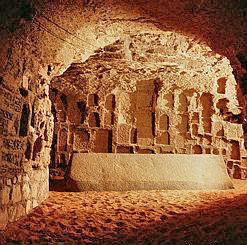
The Serapeum, at
Saqqarah, Egypt; is a tomb for the holy Apis Bulls
|
"From the very beginning
of Egyptian dynastic rule and religion, the greatest celestial
compliment to the great gods was to compare them to the Bull of
Heaven.
"When the Theban priests of Ra-Amen began the drive to supersede the
Memphite-Heliopolitan religion and calendar, celestial depictions
still showed the Sun rising over the Bull of Heaven, but the Bull of
Heaven was depicted tethered and held back. Later on, when the New
Kingdom reunited Egypt with Thebes as its capital and
Amon-Ra was
elevated to supremacy, the Bull of Heaven was depicted pierced and
deflated. The Ram began to dominate celestial and monumental art and
Ra was given the epithet "Ram of the Four Winds," and was so
depicted to indicate that he was master of the four corners and four
regions of the Earth.
"Where was Thoth during that
First Intermediate Period, when in the
heavens, above and on Earth below, the Ram and its followers were
battling and chasing the Bull and its adherents....? It was a time
when, without giving up his new domains in the New World, he could
go about that in which he had become proficient - the creation of
circular observatories and the teaching of the local inhabitants at
odd and new places the "secrets of numbers" and the knowledge of the
calendar.
"....Circa 2200 B.C. was indeed a time "when in Heaven and on Earth
the fates were decided," for it was the time when a New Age, the
Age
of the Ram, was due to replace the Old Age, the
Age of the Bull.
"....Many sources indicate that Mardukís son Nabu was crisscrossing
the lands that later became known as Lands of the Bible, seeking
adherents to his fatherís side. His name Nabu, had the same meaning
and came from the same verb by which the Bible called a true
prophet: Nabi, one who receives the divine words and signs and in
turn expresses them to the people. The divine signs of which Nabu
spoke were the changing Heavens; the fact that the New Year and
other worship days no longer seemed to occur when they should have.
Nabuís weapon, in behalf of Marduk, was the calendar....
"....The truth of the matter is that even nowadays, no one can say
for sure when one "Age" has ended and other began.... The problem is
especially acute in the case of Aries, that occupies less than 30ļ
of the celestial arc, while its neighbours Taurus and
Pisces extend
beyond their official 30ļ Houses. So, if the gods disagreed, some of
them (e.g. Marduk, so well trained in sciences by his father
Enki,
and Nabu) could say: 2,160 years (the result of the
division of the Grand Precessional Cycle of 25,920 years into twelve Houses), the
Time has come. But others, (e.g. Ninurta, Thoth) could and did say:
But look to the Heavens, do you really see the change occurring?
"....The Era of Ninurta lasted about a century and a half. Then,
satisfied that the situation was under control, Ninurta departed to
some distant mission. In his stead Enlil appointed his son Nannar/Sin
to oversee Sumer and Akkad, and Ur, Nannar/Sinís "cult center,"
became the capital of revitalized empire.
"It was an appointment with more than political and hierarchical
implications, for Nannar/Sin was the "Moon god" and his elevation of
supremacy announced that the purely solar calendar of Ra/Marduk was
done with and that the lunisolar calendar of Nippur
was the only
true one - religiously and politically. To assure adherence, a high
priest knowledgeable in astronomy and celestial omens was sent from
Nippurís temple to liaison at Ur. His name was
Terah; with him was
his ten-year-old son, Abram.
"The year, by our calculations,
was 2113 B.C.
|
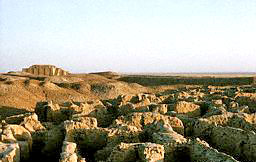
The Grand
Ziggurat, over the ruins of ancient Ur; Iraq today.
|
"....Their (Terahís,
establishing the Ur III Dynasty, and Abrahamís) saw on the one hand
the glorious culmination of the Sumerian civilization; its epitome
and hallmark was the grand ziggurat built there for Nannar/Sin - a
monumental edifice that, though lying in ruins for almost four
thousand years, still dominates the landscape and awes the viewer by
its immensity, stability, and intricacy.
"Under the active guidance of
Nannar and his spouse Ningal, Sumer
attained new heights in art and sciences, literature and urban
organization, agriculture and industry and commerce.
"....On the other hand, hanging over all this greatness and glory
was the destiny ordained by Time - the relentless change, from one
New Year to another, and the Sunís position less and less in the
House of GUD.ANNA, the "Bull of Heaven," and ever closer to that of
KU.MAL, the celestial Ram - with all dire consequences.
"Ever since it was given
Priesthood and Kingship, Mankind had known
its place and role. The "gods" were the Lords, to be
worshipped and
venerated. There was a defined hierarchy, prescribed rituals, and
holy days. The gods were strict but benevolent, their decrees were
sharp but righteous. For millennia the gods oversaw the welfare and
fate of Mankind, all the while remaining clearly apart from the
people, approachable only by the high priest on specific dates,
communicating with the king in visions and by omens. But now all
that was beginning to crumble, for the gods themselves were at odds,
citing different celestial omens and a changing calendar,
increasingly pitting nation against nation in the cause of "divine"
wars, quarrels, and bloodshed. And Mankind, confused and bewildered,
increasingly speaking of "my god" and "your god," now even began to
doubt the divine credibility.
"In such circumstances Enlil and
Nannar chose carefully the first
ruler of the new dynasty. They selected Ur-Nammu ("The Joy of Ur"),
a demigod whose mother was the goddess Ninsun.
"....Ur-Nammuís assignment was to steer the people "away from the
evil ways" of following the wrong gods. The effort was marked by the
repair and rebuilding of all the major temples in the land - with
the conspicuous exception of Mardukís temple in Babylon. The next
step was to subdue the "evil cities" where Nabu was making converts
to Marduk. To that end Enlil provided Ur-Nammu with a "Divine
Weapon" with which to "in the hostile lands heap up the rebels in
piles." That the enforcement of the Enlilite Celestial Time was a
major purpose is made clear in the text that quotes Enlilís
instructions to Ur-Nammu about the weaponís use:
As the Bull
to crash the foreign lands;
As the Lion
to hunt [the sinners] down;
to destroy the evil cities,
clear them of opposition to the Lofty Ones.
"The Bull of the equinox and the
Lion of the solstice were to be
upheld; any opponent of the Lofty Ones had to be hunted down,
crushed, destroyed.
Ur-Nammu died in a fatal accident caused by his own chariot while
leading the military expedition. The people of Ur blamed the gods
for the lack of assistance to Ur-Nammu.
As consequence of these events,
Terah (Abramís father) moved to
Harran.
In Ur, Shulgi, Ur-Nammuís son provoked Enlil for not carrying out
the divine regulations, by showing a distasteful behavior conducting
banquets and orgies in the temple of Anu himself; and for failing to
quell the "rebellion" stirred up by Nabu and Marduk. Shulgi was
sentenced to death by Enlil.
"The retreat from the western lands and the death of
Shulgi
triggered two moves. Marduk.... decided to return to the proximity
of Mesopotamia by arriving in the land of the Hittites. Abram, moved
to the land of Canaan, to position himself in the Negev, on the
Canaan-Sinai border. His mission, as we have fully detailed in
The
Wars of Gods and Men, was to protect the gateway to the spaceport.
"He (Abram) arrived there (Canaan-Sinai border) skirting the "sinful
cities" of the Canaanites; soon thereafter he went to
Egypt,
obtaining more troops and camels, for a cavalry, from the last
pharaoh of the Memphite dynasties. Back in the Negev, he was ready
to fulfill his mission.
"The anticipated conflict came to a head in the seventh year of the
reign of Shulgiís successor, Amar-Sin ("Seen by Sin").... Leading
the attack, according to the biblical record in Chapter 14 of
Genesis, was "Amraphel the king of Shiníar" and, for a long time, it
was believed that he was the Babylonian king Hammurabi. In fact, as
our own studies have shown, he was the Sumerian Amar-Sin.
"....Marching under the banner of
Sin and according to oracles given
by Inanna/Ishtar, the allied army.... smote one western land after
another. Regaining for Sin all the lands between the Euphrates and
the Jordan River, they circled the Dead Sea and set as their next
target the spaceport in the Sinai peninsula. But there Abram,
carrying out his mission, stood in their way; so they turned back
north, ready to attack the "evil cities" of the Canaanites.
"Instead of waiting in their walled cities to be attacked, the
Canaanite alliance marched forth and joined battle with the invaders
in the Valley of Siddin.
"....The "evil cities" were not obliterated, though the flight (and
resulting death) of two kings, those of Sodom and
Gomorrah, resulted
in booty and prisoners being carried away from there...., among the
prisoners was Lot, Abramís nephew.... when Abram heard that, his
cavalry pursued the invaders, catching up with them near Damascus
(now the capital of Syria). Lot, other prisoners, and the booty were
retaken and brought back to Canaan.
|

Pharaoh
Mentuhotep II |
"....The unsuccessful
military campaign depressed and confused Amar-Sin. According to the
Date Formula for the ensuing year, 2040 B.C., he left Ur and the
worship of Nannar/Sin, and became a priest in Eridu,
Enkiís "cult
center...." The year 2040 B.C. was even more memorable in
Egypt;
there, Mentuhotep II, leader of the Theban princes.... extended the
rule and rules of Ra-Amen throughout Egypt, up to the Sinai
boundary. The victory ushered in what scholars call the Middle
Kingdom of the XI and XII dynasties that lasted to about 1790 B.C.
While the full force and significance of the Age of the Ram came
into play in Egypt during the later New Kingdom, the
Theban victory
of 2040 B.C. marked the end of the Age of the Bull in the African
domains.
"....In Canaan, Abram retreated to a mountain stronghold near
Hebron. In Sumer, the new king, Shu-Sin, a brother of Aman-Sin
strengthened the defensive walls in the west, sought an alliance
with the Nippurites who had settled with Terah in Harran, and built
two large ships - possibly as a precaution, with escape in mind . .
. In a night equivalent to one in February 2031 B.C. a major lunar
eclipse occurred in Sumer; it was taken to be an ominous omen of the
nearing "eclipse" of the Moon god himself. The first victim,
however, was Shu-Sin; for by the next following year he was no
longer king.
"....Within a year of the reign of the next (and last)
king of Ur, Ibbi-Sin, raiders from the west, organized by
Nabu and encouraged by
Marduk, were clashing with Elamite mercenaries at Mesopotamiaís
gates.
"....Unlike any other time in Sumerís and
Mesopotamiaís long
history, omens were cited in unusual frequency. Judging by the
record of human behavior one may see in that a known reaction to
fear of the unknown and to a search for reassurance or guidance from
some higher power or intelligence. But at that time there was a real
cause for watching the heavens for omens, for the celestial arrival
of the Ram was becoming increasingly evident.
"As the texts that have survived from that period attest, the course
of events about to happen on Earth was closely linked to celestial
phenomena; and each side of the growing confrontation constantly
observed the skies for heavenly signs. Since the various Great
Anunnaki were associated with celestial counterparts, both zodiacal
constellations and the twelve members of the Solar System (as well
as with months), the movements and positions of the celestial bodies
associated with the chief protagonists were especially significant.
"....A text designated by scholars Prophecy Text B, known from later
copies of the original Sumerian record that was made in Nippur,
illustrates how such celestial omens were interpreted as prophecies
of the coming doom.
"....Some of those omen-prophecies directly related the
planetary
positions to the constellation Ram:
If the Ram by Jupiter will be entered
when Venus enters the Moon,
the watch will come to an end.
Woes, troubles, confusion
and bad things will occur in the lands.
People will sell their children for money.
The king of Elam will be surrounded in his palace:
. . . the destruction of Elam and its people.
If the Ram has a conjunction with the planet . . .
. . . when Venus . . . and the . . .
. . . planets can be seen . . .
. . . will rebell against the king,
. . . will seize the throne,
the whole land . . . will diminish at his command.
"In the opposing camp, the heavens were also observed for signs and
omens.... an amazing autobiographical record by Marduk of his exile,
agonizing wait for the right celestial omens, and final move to take
over the Lordship that he believed was his....
"....Various astronomical texts from the years that marked
the
transition from Taurus to Aries offer a clue regarding the omens
that Marduk was especially interested in. In those texts, as well as
in what is called by scholars "mythological texts," the association
of Marduk with Jupiter is strongly suggested .... such texts as the
Epic of Creation were rewritten (in Babylon) so as to associate
Marduk with Nibiru, the home planet of the Anunnaki. But prior to
that Jupiter, by all indications, was the celestial body of
Marduk
in his epithet "Son of the Sun"; and a suggestion - made more than a
century and a half ago - that Jupiter might have served in
Babylon
as a device parallel íto that which Sirius had served in
Egypt, as
the synchronizer of the calendrical cycle, is quite pertinent here.
"....John Landseer .... asserted that the "Caldeans" had known of
the phenomenon of precession millennia before the Greeks. Calling
those early times an era "when Astronomy was Religion" and vice
versa, he asserted that the calendar was related to the zodiacal
"mansion" of the Bull, and that the transition to
Aries was
associated with "a mystifying conjunction of the Sun and
Jupiter in
the sign of Aries, at the commencement of the great cycle of
intricate [celestial] revolutions." He believed that the Greek myths
and legends connecting Zeus/Jupiter with the Ram and its golden
fleece reflected the transition of Aries. And he calculated that
such a determining conjunction of Jupiter and the Sun in the
boundary between Taurus and Aries had occurred in the year 2142 B.C.
"....If the determining or triggering omen for Marduk/Ra was the
conjunction of Jupiter and the sun in the "mansion" of Aries, and if
it did occur in 2142 B.C. as John Landseer suggested, then this
heralding more or less coincided with the arithmetically calculated
(once in 2,160 years) zodiacal shift. That, however, would have
meant that the claim that the shift of Aries had come about preceded
by about a century and a half the observational shift of the vernal
equinox into Aries in 2000 B.C. as attested by the two tablets. The
discrepancy could explain, at least in part, the disagreement at
that time regarding what the celestial omens or observations were
truly portending.
"As the autobiographical Marduk text admits, even the omen that
signified to him the time to end his wanderings and come to Hatti
Land, the Land of the Hittites in Asia Minor, occurred twenty-four
years before his next move....
On the Enlilite side, and although the
Ram had not yet fully
dominated the New Yearís day on the spring equinox in the time of
Ibbi-Sin, the last king of Ur, the oracle priests interpreted the
omens as portents of the disastrous end.
"....In the twenty-fourth year of his sojourn in the
Land of the
Hittites, Marduk received another omen: "My days [of exile] were
completed, my years [of exile] were fulfilled," he wrote in his
memoirs. "With longing to my city Babylon I set course, to my temple
Esagila as a mount [to rebuild], my everlasting abode to
reestablish." The partly damaged tablet then describes Mardukís
route from Anatolia back to Babylon; the cities name indicate that
he first went south to Hama (the biblical Hamat), then crossed the
Euphrates at Mari; he indeed returned, as the omens had predicted,
from the west.
"The year was 2024 B.C.
"When
the Esagil (Mardukís) was eventually built, it was erected
according to very detailed and precise plans; its orientation,
height, and various stages were indeed such that its head pointed
directly to the star Iku, the lead star of the constellation Aries.
"But Mardukís ambitious vision was not to be fulfilled right then
and there. In the very same year that he began his march back to
Babylon at the head of the horde of Western supporters organized by
Nabu, a most awesome catastrophe befell the ancient Near East - a
calamity the likes of which neither Mankind nor Earth itself had
previously experienced.
"He expected that once the omens were clear, both gods and men would
heed his call for accepting his supremacy without further
resistance. "I called on the gods, all of them, to heed me,"
Marduk
wrote in his memoirs. "I called on the people along my march, íbring
your tribute to Babylon.í" Instead, he encountered a scorched-earth
policy....
"....As Mardukís followers continued their advance, the temples and
shrines of other gods began to be desecrated. The greatest sacrilege
was the defilement of Enlilís temple in Nippur, until then the
venerated religious center of all the lands and all the peoples.
When Enlil heard that even the Holy of Holies was not spared.... He
"set off a brilliance like lightning" as he came down from the
skies.... Enlil ordered that Nabu be seized and be brought before
the Council of the Gods, and Ninurta and Nergal were given the
assignment. But Nabu had escaped from his temple....
"....Meeting in
Council the Anunnaki debated what to do.... Only Enki spoke on behalf of his son
Marduk.... Enki reprimanded Nergal
for opposing his brother.... Nergal argued that the celestial omens
were being misread....
"....As the exchanges between Enki and
Nergal became harsher, Nergal,
"leaving in a huff," announced that it was necessary to "activate
that which with a mantle of radiance is covered," and thereby make
the "evil people perish." There was no way to block the takeover by
Marduk and Nabu except by the use of "the seven awesome weapons,"
whose hiding place in Africa he alone knew....
....It was
Inanna who had pointed out that time was running out ....
Inanna suggested to Enlil to continue the discussion in the privacy
of the Emeslam temple; Ninurta spoke up.... "The time has elapsed,
the hour has passed," he said. "Open up a path and let me take the
road!"
"The die was cast.
"Of the
various extant sources dealing with the fateful chain of
events, the principal and most intact one is the
Erra Epic....
Details are added by the Khedorlaomer Texts and inscriptions of
various tablets, such as those in the Oxford Editions of Cuneiform
Texts. They all describe the ominous and fateful march to its
culmination, of which we can read in Genesis, chapters 18 and 19:
the "upheavaling" of Sodom and Gomorrah and of the "evil cities" of
their plain, "and all the inhabitants of the cities, and all that
which grew on the ground."
"....The main target of obliteration was the
spaceport in the Sinai
peninsula....
* the year was 2024 B.C.
* the evidence - the immense cavity in the center of the
Sinai and
the resulting fracture lines, the vast surrounding flat area covered
with
* blackened stones
* traces of
radiation south of the Dead Sea
* the new extent and shape of the
Dead Sea - is still there, four
thousand years later.
"....Typical of the calamities that befell the once proud and
prosperous land are those listed in the
Lamentations Over the
Destruction of Ur, a long poem of some 400 verses. (Mr. Sitchin
offers a few of those verses in his Book).
"....yet to be accepted is the evidence that we have presented that
the calamity was linked to the "upheavaling" of the "evil cities"
and the spaceport in the west. It was the unexpected development of
an atmospheric vacuum, creating an immense whirlwind and a storm
that carried the radioactive cloud eastward - toward Sumer.
"....The story, however, was not the same everywhere. In
Ur, Nannar
and Ningal refused to abandon their followers and appealed to the
great Enlil to do whatever possible to avert the disaster, but
Enlil
responded that the fate of Ur could not be changed. The divine
couple spent a nightmarish night at Ur. "Of that nightís foulness
they did not flee," hiding underground "as termites." But in the
morning Ningal realized that Nannar/Sin had been afflicted, and
"hastily putting on a garment" departed the beloved Ur with the
stricken mate. In Lagash, where with Ninurta away
Bau had stayed in
the Girsu by herself, the goddess could not force herself to leave.
Lingering behind "she wept bitterly for her holy temple, for her
city." The delay almost cost her life: "On that day, the storm
caught up with her, with the Lady."
"....Enki, we learn took cover some distance away from the windís
path, yet close enough to be able to return to the city after the
cloud had passed. He found a city "smothered with silence, its
residents stacked up in heaps." But here and there there were
survivors, and Enki led them southward, to the desert. It was an
"inimical land," uninhabitable; but using his scientific prowess,
Enki - like Yahweh half a millennium later in the Sinai desert -
managed miraculously to provide water and food for "those who have
been displaced from Eridu."
"....Alerted and advised by his father,
Marduk urged the cityís
people to leave and hurry northward; and, in words reminiscent of
the angelsí advice to Lot and his family as they were told to leave
Sodom before the upheavaling, Marduk told the escapees "neither to
turn nor to look back." If escape was not possible, they were told to
"get thee into a chamber below the earth, into a darkness." Once the
Evil Storm had passed, they were not to consume any of the food or
beverage in the city, for they might have been "touched by the
ghost."
"....Life began to stir anew only seven years later. Backed by
Elamite and Gutian troops loyal to Ninurta, a semblance of organized
society returned to Sumer under rulers seated in former provincial
centers, Isin and Larsa. It was only after the passage of seventy
years - the same interval that later applied to the restoration of
the temple of Jerusalem - that the temple in Nippur was restored.
But the "gods who determine the destinies," Anu and
Enlil, saw no
purpose in resurrecting the past. As Enlil had told Nannar/Sin who
had appealed in behalf of Ur -
Ur was granted kingship -
It was not granted an eternal reign.
"Marduk had won out. Within a few decades, his vision of a
king in
Babylon who would grasp his hand, rebuild the city, raise high his
ziggurat Esagil - had come true. After a halting start, the
First
Dynasty of Babylon attained the intended power and assurance that
were expressed by Hammurabi....
"....In Egypt,
unaffected by the nuclear cloud, the transition of
the Age of the Ram began right after the Theban victory and the
enthronement of the Middle Kingdom dynasties.
"....In
Mesopotamia, slowly but surely, the ascendancy of the
Age of
the Ram was recognized by changes in the calendar and in the lists
of celestial stars.... Iku was the "alpha" or lead star of the
constellation of the Ram; it is still known by its Arabic name
Hamal,
meaning "male sheep."
"The New Age had arrived, in the heavens and on Earth. It was to
dominate the next two millennia and the astronomy that the "Chaldeans"
had transmitted to the Greeks. When, in closing years of the fourth
century B.C., Alexander came to believe that he was entitled - like
Gilgamesh 2,500 years earlier - to immortality because his
true
father was the Egyptian god Amon, he went to the godís oracle place
in Egyptís western desert to seek confirmation. Having received it,
he struck silver coins bearing his image adorned with the horns of
the Ram.
"A few centuries later the Ram faded and was replaced by the sign of
the Fishes, Pisces. But that, as the saying goes, is already
history.
Return
|















